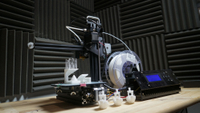This is the world's cheapest 3D printer – just make sure you're good at DIY
You'll have to build the Tronxy X1 from scratch

The ability to print three dimensional objects has caught the imagination of millions. Now, a little-known Chinese company is selling what is possibly the cheapest 3D printer on the market.
The Tronxy X1 is a fine entry level model, but like many of its competitors does not come pre-assembled. This means you'll have to put it together it yourself using a video guide (which is at least better than a paper manual).
The machine usually retails for $108.99, but use the code V3C5D1885661D000 at checkout with Gearbest to bring the price down to $99.99 / £81.06 / AU$158.61.
- These are the best home printers
- Why not read our list of best Mac printers
- Checkout the list of best printers of 2020
Tronxy X1 3D printer - $99.99 / £81.06 / AU$158.61 at Gearbest
The price of 3D printers has dropped considerably in recent months, making them a viable impulse purchase. Just bear in mind the print quality might not be exceptional, as it can only print in mono-colour and the cost of consumables can quickly rack up.
The Tronxy X1 has a maximum printing volume of 150 x 150 x 150mm - great for an introduction to 3D printing - and uses widely available (and therefore cheap) PLA filaments. A 0.4mm nozzle is provided by default, but finer models all the way down to 0.1mm are also available.
You can either print directly via a computer or use an SD card to load your designs. Just bear in mind 3D printing involves a steep learning curve and every printer - unlike their inkjet counterparts - has its own quirks.
The price includes free shipping, although you won’t be able to use other voucher codes to further reduce the cost. While Gearbest ships globally, you may have to pay additional tax depending on your location.
Check out our full review here.
Are you a pro? Subscribe to our newsletter
Sign up to the TechRadar Pro newsletter to get all the top news, opinion, features and guidance your business needs to succeed!
- Here's our choice of the best small business printers for 2020

Désiré has been musing and writing about technology during a career spanning four decades. He dabbled in website builders and web hosting when DHTML and frames were in vogue and started narrating about the impact of technology on society just before the start of the Y2K hysteria at the turn of the last millennium.
Most Popular





